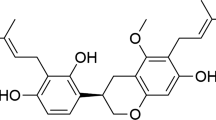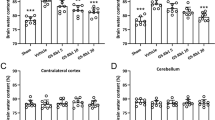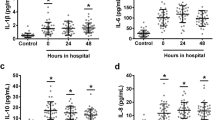Abstract
Cornel iridoid glycoside (CIG) is the active ingredient extracted from Cornus officinalis. Our previous studies showed that CIG had protective effects on several brain injury models. In the present study, we aimed to examine the effects and elucidate the mechanisms of CIG against traumatic brain injury (TBI). TBI was induced in the right cerebral cortex of male adult rats. The neurological and cognitive functions were evaluated by modified neurological severity score (mNSS) and object recognition test (ORT), respectively. The level of serum S100β was measured by an ELISA method. Nissl staining was used to estimate the neuron survival in the brain. The expression of proteins was determined by western blot and/or immunohistochemical staining. We found that intragastric administration of CIG in TBI rats ameliorated the neurological defects and cognitive impairment, and alleviated the neuronal loss in the injured brain. In the acute stage of TBI (24–72 h), CIG decreased the level of S100β in the serum and brain, increased the ratio of Bcl-2/Bax and decreased the expression of caspase-3 in the injured cortex. Moreover, the treatment with CIG for 30 days increased the levels of nerve growth factor (NGF) and brain-derived neurotrophic factor (BDNF), enhanced the expression of synapsin I, synaptophysin and postsynaptic density protein 95 (PSD-95), and inhibited the apoptosis-regulating factors in the chronic stage of TBI. The present study demonstrated that CIG had neuroprotective effects against TBI through inhibiting apoptosis in the acute stage and promoting neurorestoration in the chronic stage. The results suggest that CIG may be beneficial to TBI therapy.








Similar content being viewed by others
References
Maas AI, Stocchetti N, Bullock R (2008) Moderate and severe traumatic brain injury in adults. Lancet Neurol 7:728–741
Riggio S (2011) Traumatic brain injury and its neurobehavioral sequelae. Neurol Clin 29:35–47
Miñambres E, Ballesteros MA, Mayorga M, Marin MJ, Muñoz P, Figols J, López-Hoyos M (2008) Cerebral apoptosis in severe traumatic brain injury patients: an in vitro, in vivo, and post mortem study. J Neurotrauma 25:581–591
Loane DJ, Faden AI (2010) Neuroprotection for traumatic brain injury: translational challenges and emerging therapeutic strategies. Trends Pharmacol Sci 31:596e604
Xiong Y, Mahmood A, Chopp M (2010) Neurorestorative treatments for traumatic brain injury. Discov Med 10:434–442
Stoica B, Byrnes K, Faden AI (2009) Multifunctional drug treatment in neurotrauma. Neurotherapeutics 6:14–27
Song SQ, Zhang XC (2006) Experience analysis of using Cornus officinalis. Jilin J Tradit Chin Med 26:3–5
Zhao YW, Zhang B, Zhang WL, Liu YQ (2010) Rules of drug use for nourishing yin and tonifying the kidney to treat restoration stage of stroke. Lishizhen Med Materia Medica Res 21:677–679
Ya BL, Li CY, Zhang L, Wang W, Li L (2010) Cornel iridoid glycoside inhibits inflammation and apoptosis in brains of rats with focal cerebral ischemia. Neurochem Res 35:773–781
Yao RQ, Zhang L, Wang W, Li L (2009) Cornel iridoid glycoside promotes neurogenesis and angiogenesis and improves neurological function after focal cerebral ischemia in rats. Brain Res Bull 79:69–76
Zhao LH, Ding YX, Zhang L, Li L (2010) Cornel iridoid glycoside improves memory ability and promotes neuronal survival in fimbria-fornix transected rats. Eur J Pharmacol 647:68–74
Ma DL, Zhu YQ, Li YZ, Yang CC, Zhang L, Li YL, Li L, Zhang L (2016) Beneficial effects of cornel iridoid glycoside on behavioral impairment and senescence status in SAMP8 mice at different ages. Behav Brain Res 312:20–29
Tang WJ, Ma DL, Yang CC, Zhang L, Li YL, Zhang L, Li L (2016) Cornel iridoid glycoside improves locomotor impairment and decreases spinal cord damage in rats. Biomed Res Int 2016:6725381
Chen ZG, Lu YC, Zhu C, Zhang GJ, Ding XH, Jiang JY (2003) Effects of ganglioside GM1 on reduction of brain edema and amelioration of cerebral metabolism after traumatic brain injury. Chin J Traumatol 6:23–27
Rubovitch V, Zilberstein Y, Chapman J, Schreiber S, Pick CG (2017) Restoring GM1 ganglioside expression ameliorates axonal outgrowth inhibition and cognitive impairments induced by blast traumatic brain injury. Sci Rep 7:41269
Rigon A, Turkstra L, Mutlu B, Duff M (2016) The female advantage: sex as a possible protective factor against emotion recognition impairment following traumatic brain injury. Cogn Affect Behav Neurosci 16:866–875
Feeney DM, Boyeson MG, Linn RT, Murray HM, Dail WG (1981) Responses to cortical injury: I. Methodology and local effects of contusions in the rat. Brain Res 211:67–77
Bevins RA, Besheer J (2006) Object recognition in rats and mice: a one-trial non-matching-to-sample learning task to study ‘recognition memory’. Nat Protoc 1:1306–1311
Meng Y, Xiong Y, Mahmood A, Zhang Y, Qu C, Chopp M (2011) Dose-dependent neurorestorative effects of delayed treatment of traumatic brain injury with recombinant human erythropoietin in rats. J Neurosurg 115:550–560
Thau-Zuchman O, Shohami E, Alexandrovich AG, Leker RR (2012) Subacute treatment with vascular endothelial growth factor after traumatic brain injury increases angiogenesis and gliogenesis. Neuroscience 202:334–341
Zhang L, Xing Y, Ye CF, Ai HX, Wei HF, Li L (2006) Learning-memory deficit with aging in APP transgenic mice of Alzheimer’s disease and intervention by using tetrahydroxystilbene glucoside. Behav Brain Res 173:246–254
Tamaoki S, Suzuki H, Okada M, Fukui N, Isobe M, Saito T (2016) Development of an experimental rat model of hyperammonemic encephalopathy and evaluation of the effects of rifaximin. Eur J Pharmacol 779:168–176
Fujimoto ST, Longhi L, Saatman KE, Conte V, Stocchetti N, McIntosh TK (2004) Motor and cognitive function evaluation following experimental traumatic brain injury. Neurosci Biobehav Rev 28:365–378
Rabinowitz AR, Levin HS (2014) Cognitive sequelae of traumatic brain injury. Psychiatr Clin North Am 37:1–11
Winters BD, Bussey TJ (2005) Transient inactivation of perirhinal cortex disrupts encoding, retrieval, and consolidation of object recognition memory. J Neurosci 25:52–61
Di Pietro V, Amorini AM, Lazzarino G, Yakoub KM, D’Urso S, Lazzarino G, Belli A (2015) S100B and glial fibrillary acidic protein as indexes to monitor damage severity in an in vitro model of traumatic brain injury. Neurochem Res 40:991–999
Geyer C, Ulrich A, Grafe G, Stach B, Till H (2009) Diagnostic value of S100B and neuron-specific enolase in mild pediatric traumatic brain injury. J Neurosurg Pediatr 4:339–344
Kleindienst A, Hesse F, Bullock MR, Buchfelder M (2007) The neurotrophic protein S100B: value as a marker of brain damage and possible therapeutic implications. Prog Brain Res 161:317–325
Stoica BA, Faden AI (2000) Cell death mechanisms and modulation in traumatic brain injury. Neurotherapeutics 7:3–12
Clark RS, Kochanek PM, Watkins SC, Chen M, Dixon CE, Seidberg NA, Melick J, Loeffert JE, Nathaniel PD, Jin KL, Graham SH (2000) Caspase-3 mediated neuronal death after traumatic brain injury in rats. J Neurochem 74:740–753
Wu Q, Liu G, Xu L, Wen X, Cai Y, Fan W, Yao X, Huang H, Li Q (2016) Repair of neurological function in response to FK506 through CaN/NFATc1 pathway following traumatic brain injury in rats. Neurochem Res 41:2810–2818
Nathoo N, Narotam PK, Agrawal DK, Connolly CA, van Dellen JR, Barnett GH, Chetty R (2004) Influence of apoptosis on neurological outcome following traumatic cerebral contusion. J Neurosurg 101:233–240
Zhang G, Zhang F, Zhang T, Gu J, Li C, Sun Y, Yu P, Zhang Z, Wang Y (2016) Tetramethylpyrazine nitrone improves neurobehavioral functions and confers neuroprotection on rats with traumatic brain injury. Neurochem Res 41:2948–2957
Conti AC, Raghupathi R, Trojanowski JQ, McIntosh TK (1998) Experimental brain injury induces regionally distinct apoptosis during the acute and delayed post-traumatic period. J Neurosci 18:5663–5672
Yatsiv I, Grigoriadis N, Simeonidou C, Stahel PF, Schmidt OI, Alexandrovitch AG, Tsenter J, Shohami E (2005) Erythropoietin is neuroprotective, improves functional recovery, and reduces neuronal apoptosis and inflammation in a rodent model of experimental closed head injury. FASEB J 19:1701–1703
Logsdon AF, Lucke-Wold BP, Nguyen L, Matsumoto RR, Turner RC, Rosen CL, Huber JD (2016) Salubrinal reduces oxidative stress, neuroinflammation and impulsive-like behavior in a rodent model of traumatic brain injury. Brain Res 1643:140–151
Khuman J, Meehan WP 3rd, Zhu X, Qiu J, Hoffmann U, Zhang J, Giovannone E, Lo EH, Whalen MJ (2011) Tumor necrosis factor alpha and Fas receptor contribute to cognitive deficits independent of cell death after concussive traumatic brain injury in mice. J Cereb Blood Flow Metab 31:778–789
Campbell SJ, Deacon RM, Jiang Y. Ferrari C, Pitossi FJ, Anthony DC (2007) Overexpression of IL-1beta by adenoviral-mediated gene transfer in the rat brain causes a prolonged hepatic chemokine response, axonal injury and the suppression of spontaneous behaviour. Neurobiol Dis 27:151–163
Csuka E, Morganti KMC, Lenzlinger PM, Joller H, Trentz O, Kossmann T (1999) IL-10 levels in cerebrospinal fluid and serum of patients with severe traumatic brain injury: relationship to IL-6, TNF-alpha, TGF-beta1, and blood-brain barrier function. J Neuroimmunol 101:211–221
Wang N, Li L (2010) Effects of cornel iridoid glycoside on inflammatory reaction in the brain of traumatic brain injury rat model. Chin J Clin Pharmacol Ther 15:255–259
Aloe L, Rocco ML, Bianchi P, Manni L (2012) Nerve growth factor: from the early discoveries to the potential clinical use. J Transl Med 10:239
Yuan J, Yankner BA (2000) Apoptosis in the nervous system. Nature 407:802–809
Finkbeiner S (2000) CREB couples neurotrophin signals to survival messages. Neuron 25:11–14
Zuo D, Lin L, Liu Y, Wang C, Xu J, Sun F, Li L, Li Z, Wu Y (2016) Baicalin attenuates ketamine-induced neurotoxicity in the developing rats: Involvement of PI3K/Akt and CREB/BDNF/Bcl-2 pathways. Neurotox Res 30:159–172
Zhao Z, Sabirzhanov B, Wu J, Faden AI, Stoica BA (2015) Voluntary exercise preconditioning activates multiple antiapoptotic mechanisms and improves neurological recovery after experimental traumatic brain injury. J Neurotrauma 32:1347–1360
Chiaretti A, Conti G, Falsini B, Buonsenso D, Crasti M, Manni L, Soligo M, Fantacci C, Genovese O, Calcagni ML, Di Giuda D, Mattoli MV, Cocciolillo F, Ferrara P, Ruggiero A, Staccioli S, Colafati GS, Riccardi R (2017) Intranasal nerve growth factor administration improves cerebral functions in a child with severe traumatic brain injury: a case report. Brain Inj 31:1538–1547
Kim HJ, Lee JH, Kim SH (2010) Therapeutic effects of human mesenchymal stem cells on traumatic brain injury in rats: secretion of neurotrophic factors and inhibition of apoptosis. J Neurotrauma 27:131–138
Griesbach GS, Hovda DA, Gomez-Pinilla F (2009) Exercise-induced improvement in cognitive performance after traumatic brain injury in rats is dependent on BDNF activation. Brain Res 1288:105–115
Lu B, Nagappan G, Lu Y (2014) BDNF and synaptic plasticity, cognitive function, and dysfunction. Handb Exp Pharmacol 220:223–250
Oyesiku NM, Evans CO, Houston S, Darrell RS, Smith JS, Fulop ZL, Dixon CE, Stein DG (1999) Regional changes in the expression of neurotrophic factors and their receptors following acute traumatic brain injury in the adult rat brain. Brain Res 833:161–172
Yang K, Perez-Polo JR, Mu XS, Yan HQ, Xue JJ, Iwamoto Y, Liu SJ, Dixon CE, Hayes RL (1996) Increased expression of brain-derived neurotrophic factor but not neurotrophin-3 mRNA in rat brain after cortical impact injury. J Neurosci Res 44:157–164
Lin T, Zhang XT (2008) Effects of marrow stroma cells on the expression of nerve growth factor and brain-derived neurotrophic factor after traumatic rat brain injury. Heilongjiang Med Pharm 31:3–5
Hicks RR, Li C, Zhang L, Dhillon HS, Prasad MR, Seroogy KB (1999) Alterations in BDNF and trkB mRNA levels in the cerebral cortex following experimental brain trauma in rats. J Neurotrauma 16:501–510
Wen Z, Li D, Shen M, Chen G (2017) Therapeutic potentials of synapses after traumatic brain injury: a comprehensive review. Neural Plast 2017:4296075
Merlo L, Cimino F, Angileri FF, La Torre D, Conti A, Cardali SM, Saija A, Germanò A (2014) Alteration in synaptic junction proteins following traumatic brain injury. J Neurotrauma 31:1375–1385
Hilfiker S, Pieribone VA, Czernik AJ, Kao HT, Augustine GJ, Greengard P (1999) Synapsins as regulators of neurotransmitter release. Philos Trans R Soc Lond B 354:269–279
Südhof TC (1995) The synaptic vesicle cycle: a cascade of protein-protein interactions. Nature 375:645–653
Feng Y, Cui Y, Gao JL, Li R, Jiang XH, Tian YX, Wang KJ, Li MH, Zhang HA, Cui JZ (2016) Neuroprotective effects of resveratrol against traumatic brain injury in rats: involvement of synaptic proteins and neuronal autophagy. Mol Med Rep 13:5248–5254
Wakade C, Sukumari-Ramesh S, Laird MD, Dhandapani KM, Vender JR (2010) Delayed reduction in hippocampal postsynaptic density protein-95 expression temporally correlates with cognitive dysfunction following controlled cortical impact in mice. J Neurosurg 113:1195–1201
Berninger B, Schinder AF, Poo MM (1999) Synaptic reliability correlates with reduced susceptibility to synaptic potentiation by brain-derived neurotrophic factor. Learn Mem 6:232–242
Luikart BW, Zhang W, Wayman GA, Kwon CH, Westbrook GL, Parada LF (2008) Neurotrophin-dependent dendritic filopodial motility: a convergence on PI3K signaling. J Neurosci 28:7006–7012
Alonso M, Medina JH, Pozzo-Miller L (2004) ERK1/2 activation is necessary for BDNF to increase dendritic spine density in hippocampal CA1 pyramidal neurons. Learn Mem 11:172–178
Bamji SX, Rico B, Kimes N, Reichardt LF (2006) BDNF mobilizes synaptic vesicles and enhances synapse formation by disrupting cadherin-beta-catenin interactions. J Cell Biol 174:289–299
Acknowledgements
This research was supported by National Natural Science Foundation of China (81273498, 81341087, 81473373); National Key Research and Development Program of China (2016YFC0103909); Beijing Municipal Science & Technology Commission project (Z161100000516008); Beijing High-level Health and Technical Personal Plan (2011-1-7, 2014-2-014).
Author information
Authors and Affiliations
Corresponding authors
Ethics declarations
Conflict of interest
The authors declare that there are no conflicts of interest associated with this manuscript.
Rights and permissions
About this article
Cite this article
Ma, D., Wang, N., Fan, X. et al. Protective Effects of Cornel Iridoid Glycoside in Rats After Traumatic Brain Injury. Neurochem Res 43, 959–971 (2018). https://doi.org/10.1007/s11064-018-2501-3
Received:
Revised:
Accepted:
Published:
Issue Date:
DOI: https://doi.org/10.1007/s11064-018-2501-3




